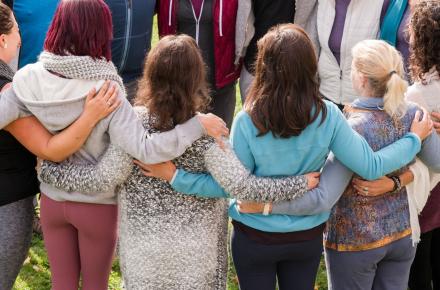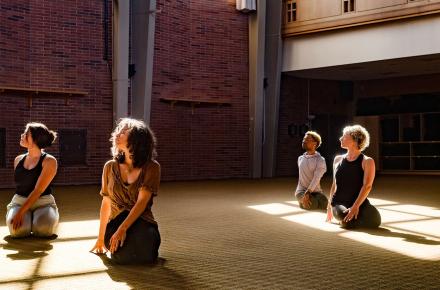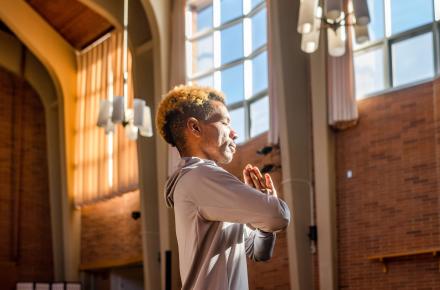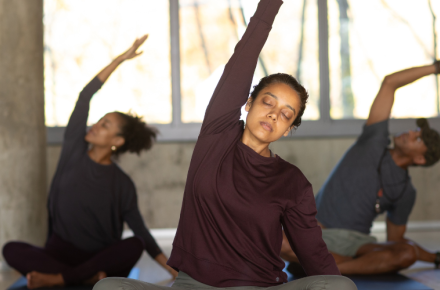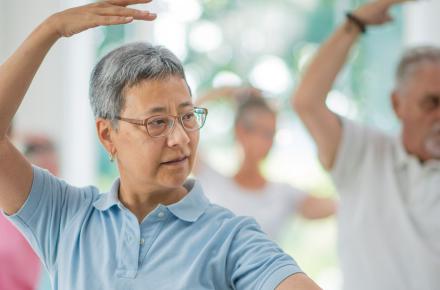Movement Plus Joy: Let Your Yoga Dance for Parkinson’s

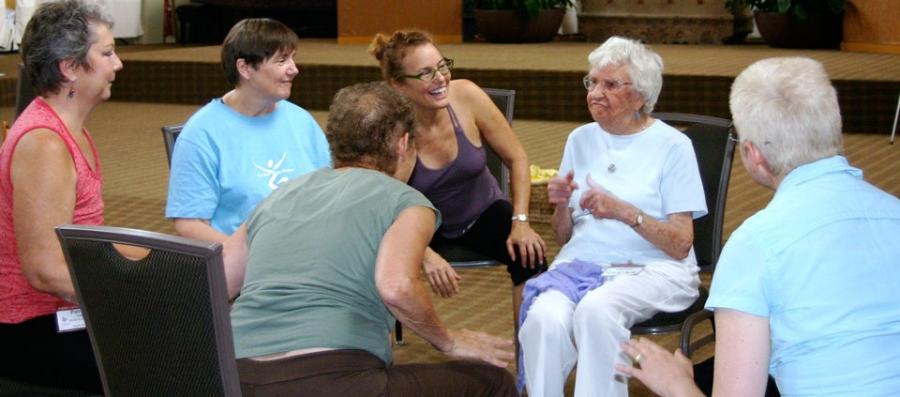
I am a lifelong dancer. While living, working, and teaching at Kripalu years ago, I took the established noon Danskinetics class, and evolved it into my own practice, combining the chakras (the body’s energy centers) with yoga and dance. I named it Let Your Yoga Dance. In the 16 years since, it has become my spiritual path and birthed a worldwide community of fellow teachers and practitioners.
Around 2005, people with Parkinson’s disease (PD) started showing up in my classes. I knew nothing about PD at the time, but I felt called to help these students regain hope, stability, flexibility, and perhaps some fun in their bodies. I started researching the topic, reading everything I could about Parkinson's. I asked my students with PD to teach me what was happening in their bodies and how we could dance them into more freedom. I started experimenting with movements, postures, and breathing interventions that could be useful. In 2007, David Leventhal, director of Dance for PD, and I teamed up to codirect a pilot PD group in the Berkshires; soon I started teaching my first Let Your Yoga Dance for Parkinson’s classes in Richmond, Massachusetts.
Find out about Megha's Let Your Yoga Dance for Parkinson's classes on Zoom.
Over time, others with different issues would stop in to take the class, and stayed. I soon realized that my initial work for people with Parkinson’s was also useful for others. So in 2012, I created a new training: Let Your Yoga Dance Teacher Training for Special Populations. This training became a dance of yoga in and around chairs for anyone wishing to help those with challenges in their body: the elderly; people with Parkinson’s, arthritis, MS, traumatic brain injury; those overcoming the effects of chemotherapy; “wellders” (able elders); those with broken or sprained limbs, and other issues. As trainees received Let Your Yoga Dance tools and techniques to take home to their community, I also included an actual Special Populations class, so the trainees could observe and participate with students who had minor or major physical challenges.
What I've Learned About the Benefits
In these 10 years of teaching people with Parkinson’s, I have learned a tremendous amount. I’ve discovered that physical therapy exercises for PD tend to be under-practiced, so I continually ask, “How can I bring physical therapy into Let Your Yoga Dance and yoga classes so the exercises become dancing yoga, and they are fun and will stick?” Few people with PD breathe deeply enough; many live in fear (justifiably so). So we practice yogic pranayama adapted to their bodies. I have created titles for the breaths: the “Happy Birthday Candle Breath,” the “Helium Balloon Breath,” and the “You’re Hilarious HA Breath.” In every class, I remind my Parkinson’s dancers of an important Let Your Yoga Dance teaching tenet: “Fear and breath cannot live in the same place.”
Good posture is a huge issue for people with PD; they tend to hunch over. Hence, constant review of the Mountain pose and Mountain dances, along with extension of the spine. Big stretches are needed and included with each class, along with cross-crawling movements of the arms, to help with stability and movement ease. I have discovered that partnering to tango music, with its stops, starts, twists, and turns, is very beneficial. Because depression is a common side effect of the disease, I have choreographed many dances to world music and Broadway tunes that help my dancing yogis move their bodies joyfully, laugh more, feel more empowered, and raise their voices in song and mantra. I ask them to make as much noise as they possibly can.
Studies show that when people with Parkinson’s practice yoga, boxing, biking, movement, dance, or tai chi, they experience enormous benefits. Let Your Yoga Dance brings all these modalities together—and more. Research now being done by Maria McManus, PhD candidate at the University of Claremont in California, is demonstrating that Let Your Yoga Dance is a harbinger for joy, immediately after the class, as well as six months later.
How the Practice Works
Let Your Yoga Dance is a yoga and breath-based conscious movement practice in which joy and fun meet depth and sacredness. The mission of Let Your Yoga Dance is to spread joy and consciousness throughout the world by transmitting body health, brain health, heart health, and soul health to all populations. Let Your Yoga Dance for Parkinson’s is a gentle, moving celebration of spirit. It is done in and around chairs, combining user-friendly dance with wonderfully evocative music from around the world. It’s unique: It is a healing practice that literally anyone can do because it is offered is a safe, kind, compassionate environment. We can dance anywhere and everywhere. That includes a hospital bed.
There is a strong yoga component in Let Your Yoga Dance for PD. Dancing our yoga in and around chairs, we use yoga vocabulary as the foundation for the practice, including the codes of conduct—the yamas and niyamas. Yogic pranayama (breath) is an integral part of the practice. We explore modifications of the Sun and/or Moon Salutations in each class, along with standing balancing poses and movements, with the assistance of sturdy chairs.
One of the distinctions between yoga and Let Your Yoga Dance for PD is that, in yoga, we are primarily practicing introversion, focusing on the self and our relationship to our own body. But in Let Your Yoga Dance, we do that, and more. We also focus on community. We look into one another’s eyes. Through the practice, these wonderful people can develop special friendships and support systems.
Five Guidelines for Let Your Yoga Dance for Parkinson’s
I frequently remind my students:
- Your dance of yoga will be different from anyone else’s, and must be respected. The person next to you might be dancing with a walker. The person on the other side of you might be more spry. The person across the circle might be in a wheelchair.
- As we dance our yoga together, community is created. We have each other’s backs.
- If any movement is offered in the class that does not suit you, do not do it. We can modify any movement or posture to suit your body.
- If you are dancing beneath your standards, lower your standards!
- Remember: We are all dancers.
10 Reasons Why People Benefit from Let Your Yoga Dance for Parkinson’s
The practice can
- Break the isolation of being alone with a progressive disease. People with PD and their caregivers come together in a safe, easeful environment to learn to dance their yoga.
- Increase flexibility and strength, helping people with PD to safely practice repetitive movements while sitting in a chair and standing
- Promote mental activity through engaging in simple and challenging movements of the body
- Stimulate all the senses
- Develop body awareness and good posture; improve ability to walk, move, and dance confidently
- Engage the mind, body, and spirit simultaneously
- Stimulate the brain through playing with all kinds of musical rhythms
- Fortify the breath. In the time-honored practice of yoga, breathing exercises naturally activate the parasympathetic nervous system, the body's relaxation response. Deep breathing fosters deep relaxation, which is essential for someone with PD.
- Create an express route to joy, through a natural merging of yoga, dance, movement, and music
- Lessen symptoms of depression through focusing on fun and on the healing of the multidimensional self.
From Parkinson’s to Special Populations
Over time, I saw with delight that my Parkinson’s students and their loved ones could let their yoga dance quite beautifully. I saw that nothing could spread joy and goodwill as quickly as user-friendly dance—with just enough challenge and community focus to broaden and build positivity, while creating new connections in the brain.
I then realized that Let Your Yoga Dance for Parkinson’s could benefit anyone, no matter what challenges were going on in the body. Eventually, I began to teach people with all kinds of autoimmune issues, bringing the practice to elders, those overcoming the effects of chemo, women healing from breast cancer, trauma survivors, and those with arthritis, Alzheimer's, MS, chronic fatigue, fibromyalgia, osteoporosis ...The list is now endless. Everything in Let Your Yoga Dance can be tailored to suit whatever the population may be. Seven years ago, I created a new training: Let Your Yoga Dance Teacher Training for Special Populations. Our instructors are teaching around the world.
One of my first students with PD, Ed Rudman, told me, “People with Parkinson’s don’t tend to smile very much. Let Your Yoga Dance brings back the smile. My PD medication brings with it all kinds of harsh side effects. There is only one side effect with Let Your Yoga Dance: joy!”
Find out more about upcoming programs and trainings with Megha Nancy Buttenheim at Kripalu.
© Kripalu Center for Yoga & Health. All rights reserved. To request permission to reprint, please e-mail editor@kripalu.org.

































